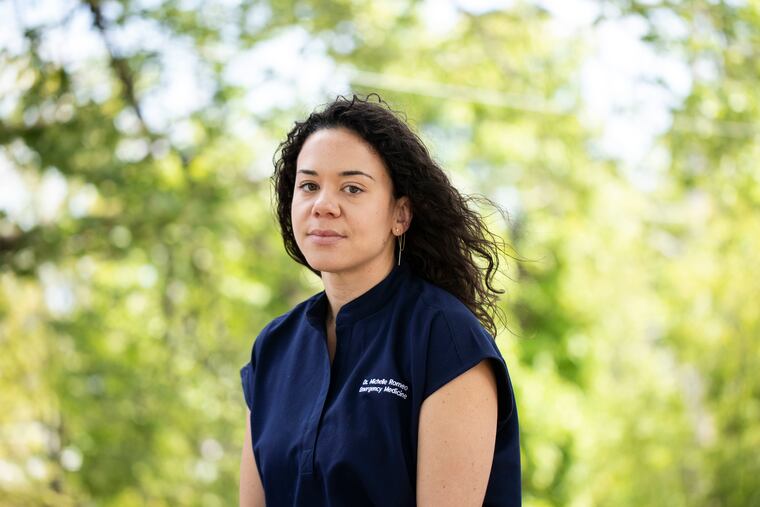ER doc: America is bleeding out, and Philly is ground zero
In 4 years at a Manhattan trauma hospital, I saw a handful of gun violence victims. In my first four hours in Philadelphia, I watched two die.

When you hammer through someone’s chest bone, it makes a loud crack. The sound always takes me by surprise.
On a recent shift, while helping a hesitant trainee place a lifesaving intravenous line, I studied the seasoned trauma surgeon across a patient’s torso. She seamlessly hammered through his chest bone to perform what is called the “clamshell” — the hail Mary of all procedures, in which a person’s chest is pried opened to find any injury that can be temporarily repaired, helping patients survive long enough to make it to the operating room.
She cut through his ribs, and blood poured out onto the floor, splashing the shoes I purposely save for trauma shifts. I stared into his flayed chest, and instantly knew the outcome. This young man’s gunshot injuries were too extensive. He had no heartbeat and holes riddle his chest cavity. Minutes after he arrived, we called his time of death.
Each death is hard, but this one hit differently. He was my coworker’s nephew.
So while his blood seeped into my shoes, I had to tell her how we had tried every measure. How we ultimately couldn’t save him. She embraced me, her fogged glasses pressing into my cheek, and said into my ear she knew we had done everything we could. Though she and I both knew, anything we could possibly do in the emergency room would never be enough to combat the senseless violence outside its doors.
I trained for four years in a Manhattan trauma hospital, and during that time saw only a handful of patients who fell victim to gun violence. During my first four hours as an attending physician in Philadelphia, I watched two patients die after being shot. By my fourth month in this role, my shoes were stained with the decimation of a community.
While the country has experienced sharp spikes in violent crimes since 2020, Philadelphia reached an all-time record for homicides in 2021. Currently, the number-one cause of premature death in this country is gun violence. Which I believe, because I see it almost every shift.
This is a much larger public health crisis that is uniquely American. Of all the countries in the world, the United States has the largest rate of civilian-held firearms — 120 for every 100 residents. Yemen, in second place, has 53 for every 100 residents. We are living in a dystopian society where firearms outnumber its people.
I understand the freedom and rights related to bearing arms that’s written into the Constitution — but as an emergency-room doctor, I see gun violence taking away the right to health and safety from more Americans every day.
Even just a civilian ban on assault-type rifles and semiautomatic weapons would help alleviate this suffering. While the majority of gun deaths in the United States occur via handguns, assault-type rifles are often responsible for mass shooting events. Polls show that there is public support in favor of an assault-rifle ban, and that a majority of people believe easy access to firearms is a large factor in mass shootings. Purchasing a gun shouldn’t be as easy as buying clothes online, as consumer sites advertise not only the products but the shiny accessories to go with them. While background checks and implementing serial numbers on ghost guns are steps toward accountability, these are small solutions, which won’t address a much larger problem.
In medicine, we spend our days weighing the risks vs. benefits of giving medications, performing procedures, and discharging patients from the hospital. In most situations, the benefit of placing a lifesaving catheter in an emergency situation outweighs the risk of dying from blood loss. Does the benefit of keeping the right to bear — and ultimately fire — arms outweigh the risk to public safety, to the destruction of local communities, to the mental well-being of entire cities?
“It feels as if we are placing Band-Aids on a hemorrhaging society.”
The coronavirus pandemic has led 1 in 5 health-care workers to leave their careers in medicine. Since I’ve moved to Philadelphia, I’ve watched the epidemic from gun violence force countless seasoned nurses and colleagues to walk out of their roles forever.
I understand their pain. We came into medicine to help our communities and save lives. But after we treat patients, we hear them beg to stay in the hospital until daylight, due to fear for their life outside. As long as this much gun violence is allowed to continue, we can’t fulfill the mission that brought us to work. It feels as if we are placing Band-Aids on a hemorrhaging society.
America is bleeding out. Philadelphia is bleeding out. And those in power are too scared to tighten the tourniquet to save its life.
I can’t help but wonder how many bloodstained shoes and cracked chests it will take to face our wounded reality and change something.
Michelle Romeo is an emergency-room doctor in North Philadelphia.